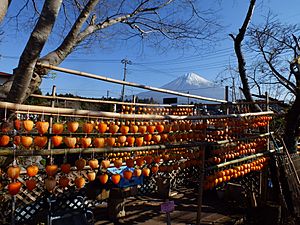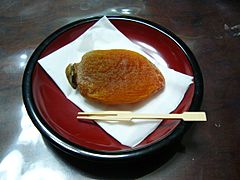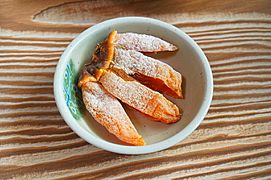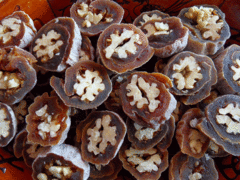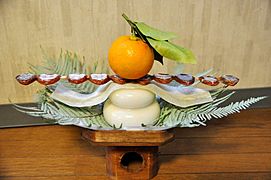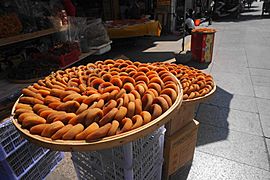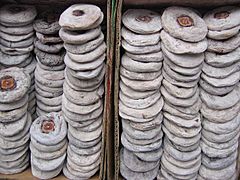Dried persimmon facts for kids
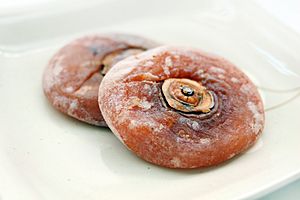
Dried persimmons
|
|
| Alternative names | Dried persimmon |
|---|---|
| Type | Dried fruit |
| Region or state | East Asia |
| Main ingredients | Oriental persimmon |
Dried persimmon is a yummy and traditional dried fruit snack. It's very popular in East Asia. People in different countries have special names for it.
In Chinese, it's called shìbǐng (柿餅). In Japanese, it's hoshigaki (干し柿). And in Korean, it's known as gotgam (곶감).
This sweet treat is usually made in the winter. It's created by air-drying a fruit called the Oriental persimmon. Besides being a snack, dried persimmon is also used in making wine, traditional teas, and other desserts.
Long ago, during the Han dynasty in China, a type of dried persimmon from Yangshao was even given as a special gift to the emperor.
Contents
How Dried Persimmons Are Made
Dried persimmons are made from different kinds of Oriental persimmon fruits. When persimmons are fully ripe, they are soft, sweet, and have thin skin. But for drying, farmers pick them when they are not fully ripe. At this stage, they are firm, and can taste a bit bitter.
Making Them in China
China has many types of dried persimmon. The old way to dry them is to pick fruits that are fully grown. First, the persimmons are peeled, and any bad spots are removed. Then, they are placed on a special drying rack. This rack is about 0.8 to 1 meter high and covered with a thin layer to protect the fruit.
The rack is put in a sunny spot with good air flow. This helps the persimmons dry well and stay clean. The fruits are placed stem-side up. They are also covered to keep away rain or dirt. As they dry, the fruit gets wrinkly. A frosty white layer often forms on the outside.
There are also modern ways to dry persimmons using machines. These methods often make the dried persimmons look brighter. Different parts of China have their own special ways of making them. Xi'an dried persimmons are very famous.
Making Them in Japan
In Japan, the persimmons are peeled first. Then, they are hung up by strings from their stems. As they dry, people gently massage them every day. This massaging gives Japanese dried persimmons a unique shape and feel. They are different from those made in China or Korea.
One special Japanese type is called Anpo-gaki. For this, the persimmons are dried using sulfur smoke. This makes them very soft and juicy.
Making Them in Korea
In Korea, persimmons are peeled and then tied with saekki (ropes made from rice straw). They are hung in a sunny, airy place. Often, they are hung under the eaves of a house.
When the persimmons turn brown and the outside gets hard, the seeds are taken out. Then, the fruits are sealed up again and flattened. After about three weeks, they lose about 75% of their weight. At this point, they are covered in dry rice straw. They are stored in a cool box until they are fully dry. A white, powdery layer of persimmon sugar forms on the outside. Sangju in North Gyeongsang Province is well-known for its delicious dried persimmons.
What's Inside Dried Persimmons?

Korean gotgam has a lot of good stuff in it. It's about 32% water. It also has protein, fat, and a good amount of carbohydrates. Plus, it's rich in fiber. A single dried persimmon (about 32 grams) has around 75.8 calories.
How People Use Dried Persimmons
Dried persimmons are not just eaten by themselves. They are also used in many tasty dishes.
In Korean Cooking
In Korean cuisine, gotgam is a popular snack. It's also used in other foods. For example, gotgam-ssam is a special treat. It's made by wrapping a walnut inside a dried persimmon.
Sometimes, dried persimmons with pine nuts inside are served with other fruit sweets. Dried persimmons are also a main ingredient for sujeonggwa, which is a traditional cinnamon punch.
In Japanese Cooking
In Japan, Hoshigaki are often eaten as a quick snack. They can also be enjoyed with walnuts. People sometimes eat them with traditional Japanese desserts. These include Dango, Mochi, or Raindrop Cake.
Fun Facts and Stories
There's a cool Chinese legend about dried persimmons. It says that the emperor Zhu Yuanzhang had to hide in the mountains. He survived by eating local dried persimmons.
In Korea, there's a famous folktale called "The Tiger and the Dried Persimmon." In this story, a big tiger is surprisingly scared of a dried persimmon!
Gallery
-
Japanese kagami mochi served with dried persimmon-skewers


